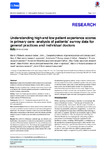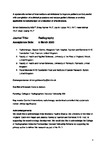Understanding high and low patient experience scores in primary care: analysis of patients' survey data for general practices and individual doctors
| dc.contributor.author | Roberts, MJ | |
| dc.contributor.author | Campbell, JL | |
| dc.contributor.author | Abel, GA | |
| dc.contributor.author | Davey, AF | |
| dc.contributor.author | Elmore, NL | |
| dc.contributor.author | Maramba, I | |
| dc.contributor.author | Carter, M | |
| dc.contributor.author | Elliott, MN | |
| dc.contributor.author | Roland, MO | |
| dc.contributor.author | Burt, JA | |
| dc.date.accessioned | 2016-03-31T07:08:50Z | |
| dc.date.available | 2016-03-31T07:08:50Z | |
| dc.date.issued | 2014-11-11 | |
| dc.identifier.issn | 1756-1833 | |
| dc.identifier.issn | 1756-1833 | |
| dc.identifier.other | ARTN g6034 | |
| dc.identifier.uri | http://hdl.handle.net/10026.1/4451 | |
| dc.description.abstract |
OBJECTIVES: To determine the extent to which practice level scores mask variation in individual performance between doctors within a practice. DESIGN: Analysis of postal survey of patients' experience of face-to-face consultations with individual general practitioners in a stratified quota sample of primary care practices. SETTING: Twenty five English general practices, selected to include a range of practice scores on doctor-patient communication items in the English national GP Patient Survey. PARTICIPANTS: 7721 of 15,172 patients (response rate 50.9%) who consulted with 105 general practitioners in 25 practices between October 2011 and June 2013. MAIN OUTCOME MEASURE: Score on doctor-patient communication items from post-consultation surveys of patients for each participating general practitioner. The amount of variance in each of six outcomes that was attributable to the practices, to the doctors, and to the patients and other residual sources of variation was calculated using hierarchical linear models. RESULTS: After control for differences in patients' age, sex, ethnicity, and health status, the proportion of variance in communication scores that was due to differences between doctors (6.4%) was considerably more than that due to practices (1.8%). The findings also suggest that higher performing practices usually contain only higher performing doctors. However, lower performing practices may contain doctors with a wide range of communication scores. CONCLUSIONS: Aggregating patients' ratings of doctors' communication skills at practice level can mask considerable variation in the performance of individual doctors, particularly in lower performing practices. Practice level surveys may be better used to "screen" for concerns about performance that require an individual level survey. Higher scoring practices are unlikely to include lower scoring doctors. However, lower scoring practices require further investigation at the level of the individual doctor to distinguish higher and lower scoring general practitioners. | |
| dc.format.extent | g6034-g6034 | |
| dc.format.medium | Electronic | |
| dc.language | en | |
| dc.language.iso | eng | |
| dc.publisher | BMJ | |
| dc.subject | Adolescent | |
| dc.subject | Adult | |
| dc.subject | Aged | |
| dc.subject | Aged, 80 and over | |
| dc.subject | Appointments and Schedules | |
| dc.subject | Communication | |
| dc.subject | Female | |
| dc.subject | General Practice | |
| dc.subject | Health Services Accessibility | |
| dc.subject | Humans | |
| dc.subject | Linear Models | |
| dc.subject | Male | |
| dc.subject | Middle Aged | |
| dc.subject | Patient Outcome Assessment | |
| dc.subject | Patient Satisfaction | |
| dc.subject | Physician-Patient Relations | |
| dc.subject | Population Surveillance | |
| dc.subject | Practice Patterns, Physicians' | |
| dc.subject | Primary Health Care | |
| dc.subject | Surveys and Questionnaires | |
| dc.subject | United Kingdom | |
| dc.subject | Young Adult | |
| dc.title | Understanding high and low patient experience scores in primary care: analysis of patients' survey data for general practices and individual doctors | |
| dc.type | journal-article | |
| dc.type | Article | |
| plymouth.author-url | https://www.ncbi.nlm.nih.gov/pubmed/25389136 | |
| plymouth.issue | nov11 3 | |
| plymouth.volume | 349 | |
| plymouth.publication-status | Published | |
| plymouth.journal | BMJ | |
| dc.identifier.doi | 10.1136/bmj.g6034 | |
| plymouth.organisational-group | /Plymouth | |
| plymouth.organisational-group | /Plymouth/Faculty of Health | |
| plymouth.organisational-group | /Plymouth/Faculty of Health/Peninsula Medical School | |
| plymouth.organisational-group | /Plymouth/REF 2021 Researchers by UoA | |
| plymouth.organisational-group | /Plymouth/REF 2021 Researchers by UoA/UoA23 Education | |
| plymouth.organisational-group | /Plymouth/Research Groups | |
| plymouth.organisational-group | /Plymouth/Research Groups/Institute of Health and Community | |
| plymouth.organisational-group | /Plymouth/Users by role | |
| plymouth.organisational-group | /Plymouth/Users by role/Academics | |
| dc.publisher.place | England | |
| dc.identifier.eissn | 1756-1833 | |
| dc.rights.embargoperiod | Not known | |
| rioxxterms.versionofrecord | 10.1136/bmj.g6034 | |
| rioxxterms.licenseref.uri | http://www.rioxx.net/licenses/all-rights-reserved | |
| rioxxterms.type | Journal Article/Review |




